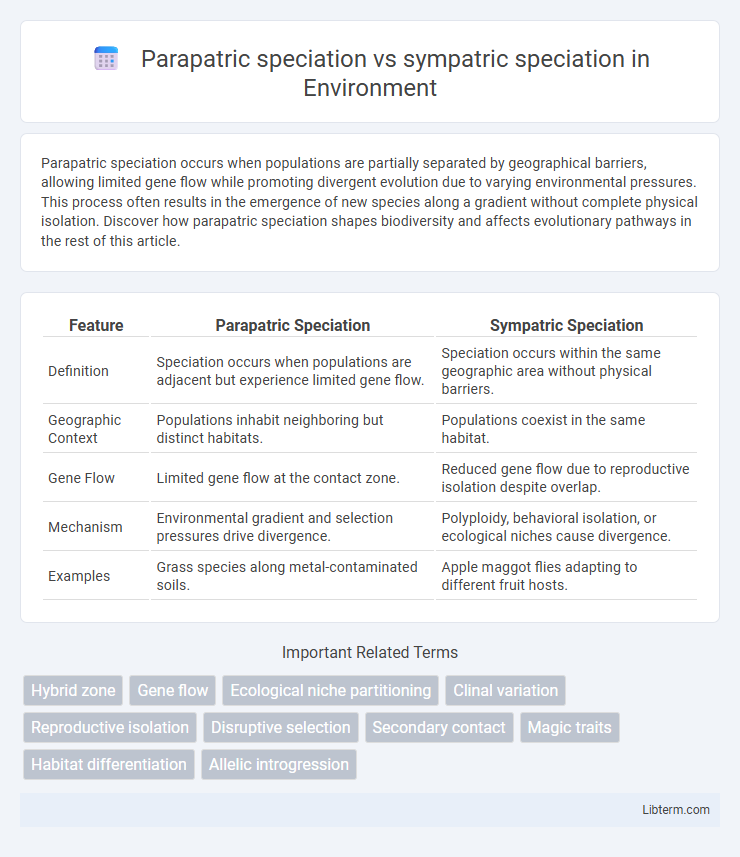Parapatric speciation occurs when populations are partially separated by geographical barriers, allowing limited gene flow while promoting divergent evolution due to varying environmental pressures. This process often results in the emergence of new species along a gradient without complete physical isolation. Discover how parapatric speciation shapes biodiversity and affects evolutionary pathways in the rest of this article.
Table of Comparison
| Feature | Parapatric Speciation | Sympatric Speciation |
|---|---|---|
| Definition | Speciation occurs when populations are adjacent but experience limited gene flow. | Speciation occurs within the same geographic area without physical barriers. |
| Geographic Context | Populations inhabit neighboring but distinct habitats. | Populations coexist in the same habitat. |
| Gene Flow | Limited gene flow at the contact zone. | Reduced gene flow due to reproductive isolation despite overlap. |
| Mechanism | Environmental gradient and selection pressures drive divergence. | Polyploidy, behavioral isolation, or ecological niches cause divergence. |
| Examples | Grass species along metal-contaminated soils. | Apple maggot flies adapting to different fruit hosts. |
Introduction to Speciation
Parapatric speciation occurs when populations of a species are partially isolated and experience limited gene flow across a geographic gradient, leading to divergence due to varying selective pressures. Sympatric speciation happens within a shared habitat where reproductive isolation arises without physical barriers, often driven by ecological niche differentiation or genetic mutations. Understanding these mechanisms provides insight into how biodiversity evolves through differential adaptation and reproductive isolation.
Defining Parapatric Speciation
Parapatric speciation occurs when populations of a species become partly geographically separated, resulting in limited gene flow and divergent evolution along a spatial gradient. Unlike sympatric speciation, where new species arise within the same geographic area, parapatric speciation involves adjacent populations experiencing varying environmental pressures that lead to reproductive isolation. This form of speciation is often observed in species distributed across environmental clines or habitats with sharp transitions.
Defining Sympatric Speciation
Sympatric speciation occurs when new species evolve from a single ancestral species while inhabiting the same geographic region, contrasting with parapatric speciation where populations are adjacent but experience limited gene flow. This process involves reproductive isolation mechanisms such as polyploidy, sexual selection, or ecological niches that reduce interbreeding within a shared habitat. Sympatric speciation is significant in understanding biodiversity, especially in organisms with high genetic variation living in homogeneous environments.
Key Mechanisms Behind Parapatric Speciation
Parapatric speciation occurs when populations are adjacent but experience limited gene flow due to environmental gradients or partial geographic barriers, leading to reduced interbreeding. Key mechanisms include divergent natural selection across different habitats causing genetic divergence and the formation of hybrid zones where hybrids have lower fitness. Unlike sympatric speciation, which occurs without physical separation, parapatric speciation relies on spatial heterogeneity to drive reproductive isolation and speciation.
Key Mechanisms Behind Sympatric Speciation
Sympatric speciation occurs when new species evolve from a single ancestral population without geographic isolation, primarily through mechanisms such as polyploidy, disruptive selection, and assortative mating. Polyploidy, especially common in plants, leads to instantaneous reproductive isolation through chromosome duplication. Disruptive selection favors extreme phenotypes over intermediates, promoting behavioral or ecological divergence that, combined with assortative mating, reduces gene flow and fosters speciation within the same environment.
Environmental Factors Influencing Both Speciation Types
Environmental factors driving parapatric speciation involve gradients or discontinuities in habitats, causing partial geographic isolation and divergent selection pressures within adjacent populations. In sympatric speciation, environmental factors such as niche differentiation, resource specialization, or sexual selection promote reproductive isolation without physical barriers. Both speciation types depend critically on ecological variables that influence gene flow, selection intensity, and adaptive divergence within populations.
Genetic Divergence in Parapatric vs Sympatric Speciation
Parapatric speciation involves genetic divergence driven by partial geographic separation, where gene flow is restricted but not completely absent, allowing localized adaptation and selection to promote differentiation. In sympatric speciation, genetic divergence occurs within a shared habitat, often through disruptive selection and reproductive isolation mechanisms like polyploidy or behavioral shifts that reduce gene flow despite physical proximity. The key distinction lies in the spatial context of gene flow, with parapatric speciation featuring a gradient of genetic differentiation and sympatric speciation relying on strong reproductive barriers to enable divergence without spatial separation.
Real-World Examples of Parapatric Speciation
Parapatric speciation occurs when populations of a species are geographically adjacent but experience limited gene flow, leading to divergence due to environmental gradients or differing selective pressures. Notable examples include the grass species *Anthoxanthum odoratum* in mine-contaminated versus uncontaminated soils in the UK and the Ensatina salamander complex in California, which exhibit clinal variations and reproductive isolation along environmental boundaries. These cases contrast with sympatric speciation, where new species arise within overlapping ranges without physical separation, such as cichlid fishes in African lakes evolving through niche differentiation.
Real-World Examples of Sympatric Speciation
Sympatric speciation occurs when new species evolve from a common ancestor without geographic isolation, often driven by genetic mutations or ecological niche differentiation. Notable real-world examples include cichlid fish in Africa's Lake Victoria, where diverse species emerged within the same habitat through variations in diet and mating preferences, and apple maggot flies (Rhagoletis pomonella) in North America, which diverged into distinct populations based on host fruit preference. These cases highlight how reproductive isolation can develop in overlapping environments through natural selection and behavioral changes.
Parapatric vs Sympatric Speciation: Comparative Analysis
Parapatric speciation occurs when populations are adjacent but experience limited gene flow, leading to divergence along environmental gradients, whereas sympatric speciation arises within overlapping geographic ranges often driven by ecological niche differentiation or genetic factors. Parapatric speciation typically involves partial isolation with some hybrid zones, contrasting with sympatric speciation's complete spatial overlap and reproductive isolation through behavioral or temporal barriers. Comparative analysis highlights that parapatric speciation emphasizes spatial environmental heterogeneity, while sympatric speciation relies more on intrinsic biological mechanisms facilitating reproductive isolation without geographic separation.
Parapatric speciation Infographic

 libterm.com
libterm.com